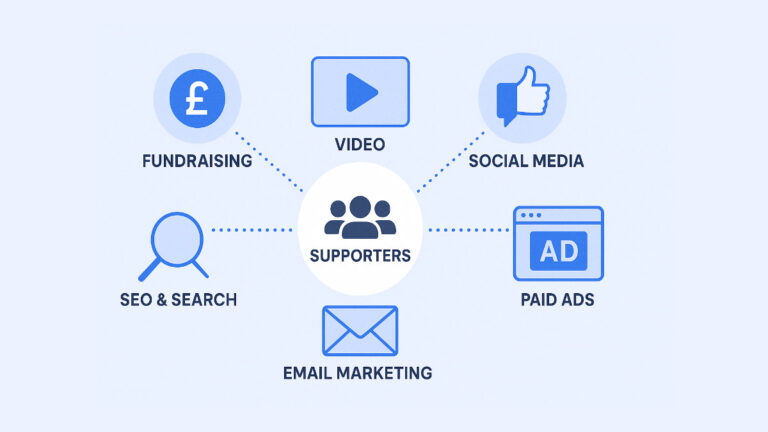In the ever-evolving and competitive charitable sector, a strong brand is crucial for a charity’s long-term success. Branding isn’t just about a logo or a tagline, it’s about creating a defined, consistent identity that resonates with supporters, volunteers and donors alike.
Here are the top three reasons why branding is fundamental for UK charities:
- Building Trust and Loyalty – A well-crafted brand establishes reliability, encouraging people to support the charity’s mission with confidence. Trust is the cornerstone of charitable giving, and a strong brand can make it easier for people to form lasting connections with the cause.
- Differentiating in a Competitive Sector – With tens of thousands of charities across the UK (more than 170K registered), standing out is essential. A clear and distinctive brand helps organisations communicate their unique mission, values and vision in a way that resonates with the right audience.
- Encouraging Strong Relationships with Stakeholders – Whether donors, partners, or volunteers, a strong brand promotes deep relationships by consistently communicating the charity’s values and purpose. This connection leads to sustained support and growth.
As charities continue to face more challenges, investing in a well-thought-out brand strategy can make all the difference in achieving their goals and making a lasting impact.
How Charity Branding Is Evolving
Charity branding evolves, affected by changing public expectations, tech innovations, and shifting donor preferences. To stay relevant and effectively engage with supporters, charities must adapt to these changes and align their brand identities with modern approaches.
1. Digital Transformation and Brand Identity
The rise of digital platforms has revolutionised how charities engage with their audiences. From websites and social media to email campaigns and online fundraising events, the digital space gives charities new ways to connect with supporters. However, this shift means that a charity’s brand identity must be consistent across multiple online channels, requiring a defined and adaptable strategy. A digital-first approach, driven by engaging content and interactive experiences, allows charities to increase their visibility and build stronger connections with the public.
2. Data-Driven Branding Decisions
The abundance of data available today provides charities with powerful insights into their supporters’ behaviours, preferences and expectations. By leveraging analytics, charities can customise their branding efforts more precisely, ensuring that their messaging resonates with the right audience. Whether through audience segmentation, donor behaviour tracking, or engagement metrics, data-driven branding allows charities to refine their strategies for maximum impact and success.
3. Building an Authentic & Personalised Charity Brand
Donors and supporters now look for deeper, more meaningful connections with the causes they care about. Personalisation has become a key element in creating those connections, whether it’s addressing a donor by name or crafting content that aligns with their interests. At the same time, authenticity remains dominant. Supporters want to know that their contributions are making a difference and they expect charities to be transparent and genuine in their messaging. Charities that demonstrate authenticity and personalisation build trust and loyalty among their audience.
4. Multi-Channel Brand Consistency
In today’s interconnected world, charities must engage with supporters across multiple channels, from social media platforms to events, email newsletters, and even traditional marketing materials. Achieving brand consistency across different channels is crucial to maintaining a coherent identity and ensuring that supporters have a seamless experience regardless of how they interact with the charity. A unified approach to messaging, design, and tone of voice can strengthen a charity’s brand and ensure that its values are consistently communicated at every touchpoint.
As the charity sector adapts to these evolving practices, it’s definite that successful branding is no longer just about a logo or a slogan. Charities must embrace digital tools, data insights and personalised engagement to create a brand identity that is relevant, authentic, and impactful in today’s fast-paced world.
Foundations of Charity Brand Identity
Creating defined and thorough brand guidelines is essential for maintaining a consistent and professional brand identity. These guidelines are a roadmap for how a charity’s brand should be represented across all touchpoints, from marketing materials to digital content. Below are the essential foundations that should be included in any charity’s brand guidelines:
1. Brand Name Use and Specifications
The proper use of a charity’s name is fundamental to its brand identity. Guidelines should specify how the charity’s name should appear across different media, including proper spelling, punctuation, and any specific formatting (e.g., capitalisation). This ensures that the charity’s name is always presented consistently, helping to build brand recognition and trust with supporters.
2. Brand Positioning Statement
A brand positioning statement defines the charity’s value proposition and position in the marketplace. It communicates the charity’s mission, target audience, and what sets it apart from other organisations. This statement should be clear, concise, and reflect the charity’s core values. It serves as the foundation for all messaging, ensuring that everyone within the organisation is aligned with the charity’s overall vision.
3. Logo Design and Use Guidelines
The logo is one of the most recognisable elements of a charity’s brand. Logo guidelines should cover all aspects of its design, including proportions, colour variations, clear space around the logo, and what is and isn’t acceptable use. This ensures that the logo is consistently applied across all media and maintains its integrity, no matter where it appears.
4. Typography and Text Styles
Typography plays a crucial role in brand identity, as it sets the tone and mood of the charity’s communication. Brand guidelines should specify which fonts must be used across all platforms, including their sizes, weights, and styles for headings, body text, and any other text elements. Consistent typography helps create a cohesive visual language and reinforces the charity’s brand personality.
5. Brand Colours and Visual Identity
Colours are powerful tools in brand recognition and emotional connection. Charity brand guidelines should outline the specific colour palette, including primary and secondary colours. These guidelines should also specify how colours should be applied in different contexts, such as websites, social media, print materials, and event branding. The visual identity should be consistent across all materials to strengthen the charity’s overall look and feel.
6. Tone of Voice and Messaging
The tone of voice defines how a charity communicates with its audience, while messaging ensures that the right messages are delivered in a good way. Brand guidelines should outline the charity’s preferred tone (e.g., friendly, empathetic, professional) and provide examples of how to craft messaging that resonates with supporters. Defined guidelines help maintain a consistent communication style, ensuring that all interactions reflect the charity’s values and mission.
Your organisation can ensure that its messaging, design, and overall presence are unified and aligned with its core mission, ultimately expanding the charity’s impact and efficiency in its community by establishing these key elements in its brand guidelines.
How to Develop a Strong Charity Brand Strategy
A solid charity brand strategy is essential for building recognition, trust, and deep connections with supporters. By defining the charity’s mission, values, and unique position, the brand becomes more than just a logo; it expresses its purpose and impact. Here’s how to create a strong brand strategy:
1. Conduct a Brand Audit
Start by assessing the current state of your charity’s brand. A thorough brand audit helps identify strengths, weaknesses, and opportunities for improvement. This involves reviewing key brand elements such as the logo, website, social media presence, and marketing materials, along with gathering feedback from stakeholders like donors, volunteers and staff. Understanding where your brand stands is the first step toward building a clearer and more effective brand strategy.
2. Define Brand Values and Mission
The mission and values of a charity form the foundation of its brand. The mission should clearly articulate the charity’s purpose, goals, and the impact it aims to make. Meanwhile, brand values represent the principles that guide the charity’s actions and decisions. These elements help ensure the charity’s messaging aligns with its core objectives and resonates with supporters, creating a deeper connection with the community.
3. Create a Unique Brand Personality
A charity’s brand personality brings its values and mission to life. Whether compassionate, bold, or inspiring, the personality should reflect the charity’s culture and resonate with its target audience. A well-defined brand personality makes the charity feel more relatable, promoting stronger emotional connections with supporters. It also serves as a distinguishing factor in a competitive charity sector.
4. Establish Brand Differentiation
In a crowded charity sector, standing out is essential. Identifying what makes your charity unique, whether a specific cause, approach, or impact is key to differentiating your brand. This unique positioning allows your charity to form a distinct identity, helping potential supporters recognise the value of contributing to your cause. By clearly communicating what sets your charity apart, you increase its appeal to donors and partners.
5. Implement Brand Consistency
Brand consistency reinforces your charity’s identity and encourages trust. Ensure your branding is applied consistently across all touchpoints, including your website, social media, marketing materials, and events. Consistent branding builds a unified experience for supporters and strengthens recognition, making it easier for them to engage with your charity. A cohesive brand presence helps establish a strong, memorable impression.
With a well-crafted strategy, your charity can establish a powerful, recognisable brand that attracts supporters, amplifies its mission and drives positive impact.
Winning Digital Branding Strategies for Charities
The digital space provides powerful opportunities for charities to strengthen their brand presence, engage supporters and expand their reach. A well-defined digital branding strategy ensures consistency across all online platforms while making the charity’s mission clear and compelling. Here’s how charities can effectively build their digital brand:
1. Optimising A Charity Website Design
A charity’s website is often the first touchpoint for potential donors and supporters. It should reflect the organisation’s brand identity through a cohesive design, colour scheme, typography, and messaging. Straightforward navigation, impactful storytelling, and a strong call to action help visitors understand the charity’s purpose and encourage engagement. Ensuring accessibility and a seamless user experience also increases credibility and trust.
2. Social Media Branding Tips
Social media platforms allow charities to amplify their message, connect with audiences, and build a community around their cause. A consistent visual style, tone of voice, and posting strategy help reinforce the charity’s brand identity. Engaging content such as behind-the-scenes stories, success stories, and user-generated content can humanise the brand, while branded templates ensure visual consistency across different posts and campaigns.
3. Email Marketing and Brand Consistency
Emails are a direct communication channel with supporters, making it crucial to maintain brand consistency in every message. From branded email templates to a distinctive tone of voice, each email should reflect the charity’s identity. Personalised messaging and well-crafted storytelling help create deeper connections with recipients, increasing long-term engagement and donor retention.
4. Mobile-Friendly Branding Approaches
With a growing number of people accessing digital content via mobile devices, charities must ensure their brand is mobile-friendly. This includes responsive website design, optimised email templates, and mobile-first social media content. Simplified navigation, fast-loading pages, and clear call-to-action buttons improve user experience, ensuring supporters can interact with the brand effortlessly on any device.
A strong digital branding strategy allows charities to create a compelling and unified brand presence online, promoting trust and encouraging deep engagement from their audience.
Building Emotional Connections through Charity Branding
Storytelling is one of the most powerful strategies in charity branding, allowing organisations to connect with supporters on a deeper emotional level. A well-crafted narrative transforms abstract causes into personal, relatable experiences, making donors and volunteers feel genuinely involved in the mission. Here’s how charities can harness storytelling to strengthen their brand:
1. Craft Compelling Brand Narratives
A strong brand narrative weaves a charity’s purpose, values, and impact into a cohesive and engaging story. It should communicate why the charity exists, the change it needs to make, and the role supporters play in achieving that vision. An authentic, human-centred approach helps build trust and emotional engagement.
2. Use Authentic Impact Stories
Nothing is more compelling than real-life stories of change. Sharing testimonials from beneficiaries, volunteers and donors brings the charity’s work to life. These stories highlight the tangible difference the organisation makes, helping potential supporters see how their contributions lead to significant outcomes. Visual storytelling through videos and images increases the emotional impact and makes the message even more memorable.
3. Leverage User-Generated Content
Encouraging supporters to share their experiences with the charity can boost credibility and build community connections. Donor testimonials, volunteer experiences and social media posts featuring personal involvement help create a more relatable and trustworthy brand. This not only strengthens engagement but also extends the charity’s reach organically.
4. Create an Emotional Tone with Supporters
To inspire action, charity branding must evoke strong emotions, whether hope, empathy or urgency. Using emotionally compelling language, visuals and storytelling techniques can make supporters feel personally invested in the cause. Aligning stories with universal human values, such as kindness and solidarity, strengthens emotional bonds and encourages long-term commitment.
Storytelling should be at the heart of a charity’s branding strategy, helping to build deeper connections, inspire action, and leave a lasting impact on supporters. When done effectively, it turns passive audiences into active advocates who feel personally connected to the cause.
Measuring Brand Success
Building a strong charity brand is only part of the journey, measuring its impact is just as crucial. Charities must track their brand’s success to ensure it resonates with their audience and drives deep engagement.
1. Charity Branding Key Performance Indicators
To assess brand success, charities should monitor key performance indicators (KPIs) such as brand awareness, audience engagement, donor retention rates, and campaign success. Metrics like website traffic, social media reach, and email open rates provide valuable insights into brand visibility and engagement levels.
2. Tools and Techniques for Brand Tracking
Various tools can help charities measure their brand’s impact. Google Analytics tracks website interactions, while social media analytics platforms provide engagement data. Surveys and donor feedback offer qualitative insights into how supporters perceive the brand. Consistently reviewing these sources ensures the brand remains relevant and successful.
3. Analysing Brand Perception and Awareness
Understanding how the public views a charity’s brand is essential. Conducting opinion analysis on social media, gathering testimonials, and tracking media mentions can reveal how well the brand message aligns with public perception. Charities can refine their messaging to increase credibility and trust if gaps exist.
4. Adjusting Brand Strategy Based on Data Insights
Data-driven decision-making allows charities to strengthen their brand over time. If certain campaigns underperform, adjusting visuals, messaging or outreach channels can improve results. Regularly reviewing branding efforts ensures the charity remains impactful, relevant and aligned with its mission.
Strategic Partnerships for Charity Brand Growth
Collaboration is a powerful strategy for charities looking to increase their brand presence, expand their reach, and maximise their impact. By working with other organisations, charities can strengthen their credibility, access new audiences and amplify their message.
1. Partnering with Other Charities
Forming alliances with like-minded charities allows organisations to pool resources, share expertise and create more impactful campaigns. Joint initiatives such as fundraising events, awareness drives, or advocacy efforts can generate greater public engagement while reinforcing shared values. When partnerships are well-aligned, both charities benefit from increased visibility and trust.
2. Corporate Partnerships and Co-Branding Opportunities
Collaborating with businesses can provide charities with financial support, marketing exposure and access to new donor bases. Corporate partnerships can take many forms, including sponsorships, cause-related marketing campaigns, or employee engagement programmes. By aligning with brands that share similar values, charities can improve their credibility while giving businesses a great way to demonstrate corporate social responsibility.
3. Managing Brand Collaborations Effectively
Successful brand collaborations require defined communication, shared goals and a strategic approach to maintaining brand integrity. Charities should establish formal agreements outlining expectations, responsibilities, and branding guidelines to ensure consistency across all materials. Regular evaluations of partnership success help refine strategies and encourage long-term relationships that benefit both parties.
Driving Sustainability in Charity Branding
As public awareness of environmental and social issues grows, charities must integrate sustainability and ethical responsibility into their branding efforts. A strong commitment to these values improves credibility, builds trust with supporters and ensures long-term impact.
1. Eco-Friendly Branding Practices
Sustainable branding goes beyond messaging, it involves tangible actions such as using recycled or biodegradable materials for print materials, reducing waste in promotional campaigns, and adopting digital-first approaches to minimise environmental impact. Even small changes, like choosing eco-friendly packaging for charity merchandise, reinforce a charity’s commitment to sustainability.
2. Ethical Branding Messaging
Supporters want to know that the organisations they back uphold ethical principles. Transparency in sourcing, fair wages for workers, and responsible fundraising practices should be reflected in brand storytelling. By openly sharing commitments to ethical operations, charities can strengthen relationships with donors and stakeholders.
3. Aligning Brand Values with Sustainability
A charity’s branding should consistently reflect its sustainability goals, ensuring alignment between its mission and its actions. This can involve advocating for environmental causes, integrating sustainability into fundraising campaigns, or forming partnerships with ethical organisations. A defined and authentic approach to sustainability strengthens brand identity and promotes deeper connections with supporters.
How to Implement Brand Guidelines
A well-defined brand is only effective if consistently applied across all communications and touchpoints. Implementing brand guidelines ensures that staff, volunteers and partners represent the charity’s identity correctly, reinforcing trust and recognition.
1. Create Complete Brand Documentation
A charity’s brand guidelines should be documented, covering essential elements such as logo use, typography, colour schemes, tone of voice and messaging principles. This documentation is a reference point for anyone involved in branding, from in-house teams to external agencies.
2. Train Staff and Volunteers on Brand Use
Ensuring brand consistency requires education. Training sessions, workshops, and digital brand resources can help staff and volunteers understand how to apply branding guidelines correctly. By encouraging a strong brand culture, charities can ensure their messaging remains cohesive across different teams and campaigns.
3. Maintain Brand Consistency Everywhere
Branding isn’t just for marketing; it should be reflected in fundraising, service delivery, and communications. Establishing internal processes and appointing brand champions in various departments can help ensure consistency and prevent unintentional deviations from brand guidelines.
4. Audit Brand Consistently
A brand is not static; it evolves alongside the charity’s growth and audience expectations. Conducting regular brand audits allows organisations to identify inconsistencies, measure efficiency, and refine branding elements as needed. Updating guidelines based on new insights ensures the brand remains relevant and impactful.
How Charity Branding is Evolving
Charity branding evolves, influenced by tech innovations and changing supporter expectations. As charities look ahead, staying ahead of emerging trends will be crucial for maintaining relevance and engagement.
1. AI in Brand Management
Artificial intelligence transforms how charities manage their brands, from automating content creation to analysing audience behaviour. AI-powered insights help charities refine their messaging, optimise donor engagement, and deliver more personalised experiences.
2. Virtual and Augmented Reality
Immersive technologies like virtual reality (VR) and augmented reality (AR) are opening new ways for charities to connect with supporters. From virtual fundraising events to interactive storytelling, these tools create deeper emotional connections and bring causes to life in compelling ways.
3. Hyper-Personalisation
Supporters now expect personalised experiences, and charities leverage data to deliver customised content, messaging, and engagement opportunities. Hyper-personalisation, driven by AI and analytics, allows charities to build stronger relationships by addressing individual preferences and behaviours.
4. Blockchain Technology
Trust and accountability are at the heart of charity branding, and blockchain technology is emerging as a tool for superior transparency. By using blockchain, charities provide verifiable proof of donations, track the impact of funds and strengthen credibility with supporters.
My Final Thoughts
A strong and well-defined brand is no longer a luxury for UK charities, it is a necessity. Throughout this guide, I have explored the essential elements of charity branding, from developing a strategic brand identity to leveraging digital tools, storytelling, and partnerships. Consistency, authenticity and emotional connection remain at the core of effective charity branding.
With years of experience helping charities build and refine their brand presence, I understand the challenges many organisations face in standing out and engaging supporters effectively. A compelling brand is not just about visuals, it is about trust, credibility and long-term sustainability.
As the charity sector evolves, investing in a strong brand will be vital for future success. Whether you need to refine your messaging, improve your digital presence, or create a more cohesive brand strategy, now is the time to take action.
If your charity is ready to strengthen its brand, I invite you to book a free consultation today. Let’s work together to create a brand that represents your mission and connects with the people who matter most.
Stay Updated with the Latest Charity Insights
Sign up for our newsletter to receive valuable tips, updates, and exclusive offers to help your charity thrive.



